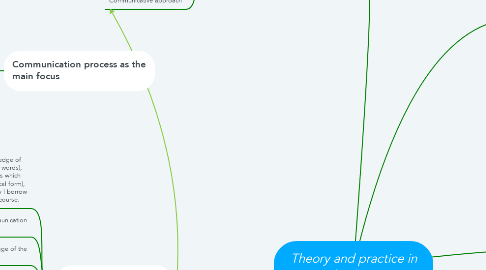
1. Influences on modern grammar teaching
1.1. Traditional grammar
1.2. Learner-based approaches
1.3. Second language acquisiation
1.4. Communicative approach
2. Language: grammar as communication system
2.1. Grammatical competence =knowledge of forms (how to form structures and words), meanings/ notions (how to express which meaning through which grammatical form), speech function, appropriacy (May I borrow this vvs Can I borrow this) and discourse.
2.2. Grammar as part of the communication model
2.3. Grammar as the final stage of the interaction process
2.4. Focus on notions instead of grammatical forms
2.4.1. Grammar teaching based on meaning and within meaningful contexts (eg teaching the gerund within the context of likes and dislikes, I like creating mindmaps but i don't like recording myself for example)
2.5. Only potential disadvantage of this approach: no trasining of the "logic" of grammar itself
2.6. Use of meaning, context and discourse as categories instead of focusing on grammatical forms
2.7. Language viewed as a mental process, that works best in an authentic context
3. Communication process as the main focus
3.1. Functions/notions
3.2. Structuring & Formatting
3.3. Output
3.4. Message
4. Theories underlying communicative grammar teaching
4.1. a) Language
4.2. b) Learning
4.3. c) Teaching --> using knowledge of a) and b) to set objectives
4.4. b) + c) determine what teaching looks like
5. Grammar as a skill: from description to methodology
5.1. competence vs performance
5.2. Aims of grammar teaching= the learners should be able to express their own ideas in real situation in a language that is as correct, meaningful and appropriate as possible
5.2.1. Teacher as a facilitator of this process
5.2.1.1. Recognising the importance of performance over competency as the main criterion of proificency
5.2.1.2. Stressing that Grammar is meaningful
5.2.1.3. Realising absolute correctness is not a realistic goal
5.2.1.4. Creating activities in which _Grammar is used actively
5.3. Away from classical introduction of grammar towards more learner-centered activities
5.3.1. increases learner motivation
5.3.2. learning by doing
5.3.3. helps learners build confidence
5.3.4. some sort of understangind of grammar rules is helpful, but it's better for students to discover them
5.3.5. Building lasting connection between competence and performance
5.3.6. using realistic and creative situations for grammar treaching as opposed to the coursebooks

